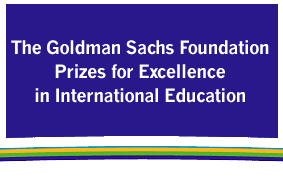Impact Statement
In June 2003, The Goldman Sachs Foundation and Asia Society created the Prizes for Excellence in International Education. The purpose of the prize program is to identify and recognize the best of the growing number of innovative examples of international education for K-12 students and teachers in the United States and those who are working to scale these models up. Four prizes of $25,000 are awarded annually to an elementary/middle school; a high school; a district or state; and a media or technology program. Past prize recipients represent diverse approaches to international education and different geographic regions of the country. All demonstrated impressive innovation in leveraging existing education resources, in exploring new approaches to teaching about the world, in curriculum, exchanges, teacher preparation, and in integrating technology and informal learning methods.
Stimulating Awareness
The prizes have garnered considerable interest across the country, bringing national attention to the critical need for investment in the development of international knowledge and skills. Press coverage of the prizes has been extensive and from this has emerged a growing interest by the press in covering international education as a part of reforming America’s high schools. Stories have run in national and international outlets including the Wall Street Journal, New York Times, Time Magazine, International Herald Tribune, ABC, several articles in Education Week, and international and other national press services.
National organizations such as the National Governors Association, Council of Chief State School Officers, and others, have focused annual conferences and meetings on the topic of international knowledge and skills, exploring it as part of an educational response to globalization.
Expanding Models
All of the former prizewinning schools have become local if not national models, receiving visits from other schools and international delegations. The Chinese American International School (2004) has sponsored two conferences on teaching Chinese. The John Stanford International School (2003), a Japanese/Spanish/English immersion elementary school, has become the model for a network of ten new international schools to be launched in Seattle. The China Exchange Initiative, which began at the Newton North and South High Schools (2005), has expanded their exchange efforts to six other states across the country.
International School of the Americas (2004) and Metropolitan Learning Center (2004) served as models to launch a new network of international studies secondary schools (ISSN), created by Asia Society and supported by the Bill and Melinda Gates Foundation, to serve low-income students in Austin, Charlotte, Chicago, Denver, Houston, Los Angeles, Mathis, TX, New York City, and San Antonio. International School of the Americas (2004) and Walter Payton Preparatory High School (2007) are now anchor schools in the network, mentoring and sharing best practices.
Six states have copied the Goldman Sachs Foundation Prizes by creating smaller prize programs regionally: Kansas, Vermont (2003), Massachusetts (2006), Ohio (2007), Washington and West Virginia have established prizes.
Disseminating Best Practices
The best practices gathered thus far during the competition have been published in several reports: Schools for the Global Age and States Prepare for the Global Age, articles in major education journals, and Educating Leaders for a Global Society, a policy report by Stephanie Bell-Rose, president, Goldman Sachs Foundation and Vishakha N. Desai, president, Asia Society, for corporate philanthropies on steps businesses and foundations can take to address this urgent need.
In July 2008, Asia Society convened educators and policymakers to share best practices at the Putting the World into World-Class Education: Asia Society’s Forum for Policymakers and Practitioners in Washington, DC. At that time Asia Society released a new guidebook, Going Global: Preparing Our Students for an Interconnected World, for middle and high schools based on the best practices in international education collected from across the country and the prizes program. Responding to the growing interest in schools, it provides teachers, administrators, and interested community leaders with the initial tools to add an international dimension in their schools. In early 2009, Expanding Horizons: Building Global Literacy in Afterschool Programs, a guidebook and DVD with strategies and resources to help afterschool programs integrate global literacy, was published. The guide is based on more than 100 interviews with leaders in afterschool and international education, a review of relevant materials, and visits to afterschool programs in several cities, including John Stanford International School (2003).
Also, in response to growing interest by schools in creating Mandarin language programs, Asia Society published Creating a Chinese Language Program in Your School: An Introductory Guide, which draws in part on prizewinners as examples. In April 2008 and 2009, Asia Society and College Board provided support for these programs through the National Chinese Language Conference.
Increasing Teacher Knowledge
Teacher professional development groups like the Association for Supervision and Curriculum Development (ASCD), Phi Delta Kappan, Model Schools Conference, National Education Association, National Staff Development Council, and National Afterschool Alliance, have made international education a theme of their annual meetings and conferences – showcasing winners and helping teachers to bring an international dimension to their classrooms.
Teacher preparation programs are also becoming interested in adding an international dimension. Asia Society co-sponsored a meeting of teacher preparation institutions to highlight the importance of bringing global perspectives to pre-service teacher preparation and recommend strategies to do so. A report, Teacher Preparation for the Global Age: The Imperative for Change, highlights promising practices identified during this meeting and subsequent discussions and suggests a framework for internationalizing the education of all pre-service teachers and increasing the number of world language teachers, especially in less commonly taught languages. The report has been widely disseminated through higher education networks.
Broadening the Reach of Technology
Winners of the technology prize have used the recognition and attention generated by the prizes program to expand to countries around the globe – and use low cost methods to allow students in every state access to world, right in their own classrooms. Sesame Workshop (2003) expanded its global awareness programming including: the website Panwapa, which aims to teach kids the world over about their roles as global citizens; and new Mandarin and Hindi speaking Muppets which expose students to other languages. A Sesame pilot program with the Ohio State Department of Education infuses Chinese language and culture into preschool and kindergarten programs. iEARN (2003) reaches over one million students daily through online collaborations with international peers in more than 115 countries. States such as Washington, New Jersey, and Ohio, have formed partnerships with iEARN to involve teachers in these international online activities. The GLOBE (2004) network has grown to include representatives from 110 participating countries. There are more than 40,000 GLOBE-trained teachers representing over 20,000 schools around the world.
Increasing World Languages
There is a growing realization at all levels that any response to globalization must include learning a second language. The prizes program has put a major emphasis on effective approaches to language learning through recognizing immersion programs at the elementary level and extended language study, including in critical languages, at the high school level. Nationally, federal funding has increased for programs on critical world languages. Many states including Minnesota, Ohio, Wisconsin, Utah, and Georgia, have allocated or are considering funding for elementary world language programs – realizing the need for a K-12 pipeline to produce students fluent in a second language. At the local level, schools and parents have increasingly demanded world language programs for their students. An example is the growing number of schools offering Mandarin programs – in just three years the number of programs has roughly doubled. Also, in 2004, when the College Board surveyed high schools across the country, 2,400 schools expressed interest in offering the AP course in Chinese language (Mandarin) and culture.
Implementing State Policies
Twenty-six states are now promoting international education through participation in the States Network on International Education in the Schools in which North Carolina (2003), Wisconsin (2004), Delaware (2005), Kentucky (2005), Massachusetts (2006), and Ohio (2007) are leaders. Examples of efforts advanced by the network:
- 20 states have developed Governor appointed councils and state summits to assess the status of international education; 12 have issued state reports/action plans.
- 12 states have introduced state legislation to incorporate a global dimension into their schools.
- 7 states are creating internationally themed high schools as part of high school reform.
- 6 states have initiated early language programs or expanded world languages requirements.
- 15 states have created new educational partnerships with China.
- 17 states have new professional development institutes to build teacher capacity.
- 8 states have appointed international education coordinators.
Putting the World into World-Class Education: State Innovations and Opportunities, a paper published in the fall of 2008, provides examples of state-led innovations to promote international education drawing from the work of the States Network on International Education in the Schools.
None of these efforts would have been possible without the recognition and awareness raising that has happened through the Goldman Sachs Prizes for Excellence in International Education. The prizewinners are models which demonstrate that international education can be realized while also meeting high achievement standards in the core curricular areas and in a way that motivates students.




